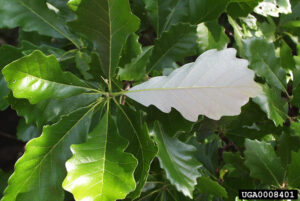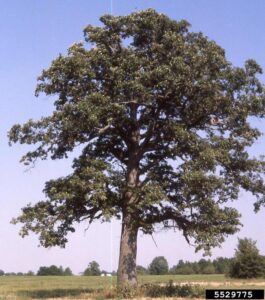
Paul Wray, Iowa State University, Bugwood.org
Scientific name: Quercus bicolor
Native to: northeastern quarter of the U.S. (including southern Wisconsin)
Mature Height*: 50-60+’
Spread*: 50-60’
Form: broad, wide-spreading
Growth Rate*: slow to moderate; 12”-18” per year
Foliage: 5”-6”; glossy green above, white below; leathery with shallow, irregular lobes; leaves often persist into winter
Fall Color: yellow-brown to orange-brown
Flowers: clusters of stem-like 3”-4” catkins; blooms late May through June
Fruit: 1” paired acorns on slender stalks up to 4” long
Bark: interesting; young bark curls back in ragged, pappery scales revealing light greenish-gray inner bark; becomes darker gray-brown, thick, and scaly with age
Site Requirements: full sun; prefers acidic soil; withstands wide range of soil texture and moisture content; moderate salt tolerance
Hardiness zone: 4a
Insect & Disease Problems: oak wilt (but less susceptible than red, black, and northern pin oak), gypsy moth, anthracnose
Suggested Applications: parks, lawns, boulevards where space is ample
Limitations: becomes chlorotic in very high pH soil
Comments: although easier to transplant than most oaks, success is best achieved by transplanting in spring
*Urban tree size and growth rate vary considerably and are strongly controlled by site conditions.

T. Davis Sydnor, The Ohio State University, Bugwood.org
(This is an updated version of an article written by retired DNR Urban Forestry Coordinator Cindy Casey for the urban forestry newsletter in 1993.)
